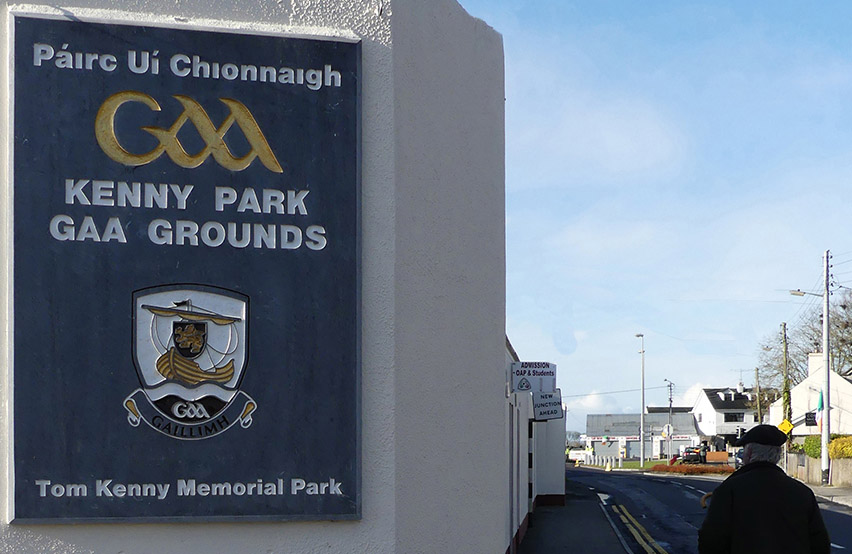Kenny Park GAA Grounds |
|
Grounds donated to the people of Athenry as a Town Park The 'Back Lawn' Kenny Park lies within Athenry's original town walls, constructed in the 1300s by the de Burgh family. They remain among the best preserved medieval walls in Ireland. The land on the South Moat side of the town was the site of a hospital which included a leper compound in the 14th and 15th centuries. When the hospital ceased operation the area was left to the people of Athenry as a town park, and became known locally as the Back Lawn. Tom Kenny Memorial Park established A number of leading Gaels in the County decided 1947 to establish a memorial to the memory of the late Tom Kenny. It was agreed that the memorial would be a stadium and the organising Committee requested the County Board to inspect venues in the County and recommend three as suitable. The Board selected Loughrea, Craughwell and Athenry. The Committee then met and unanimously agreed on Athenry as the site for the stadium. The 'Back Lawn' as it was known was sold to the Kenny Memorial Committee by the trustees for £500 in 1952. It was an ideal site for a G.A.A. stadium, situated beside one of the few ancient town walls that existed in Ireland or the Continent. The walls were built according to some historians from the spoils of the Battle of Athenry in 1316, while others claim King John built them in 1211. Kenny Park Grounds opened On July 3rd 1953 the park was officially opened by the Chairman of the Connacht Council Mr. Don O'Rourke (Roscommon) and blessed by Fr. Delaney C.C. Speaking on the occasion the Connacht Chairman said the youth of the Parish should be proud of the stadium and thanked the people of Athenry for subscribing towards the development and the organising Committee which had worked so hard. There was a glamorous opening ceremony and among those present were surviving members of the 1923 All-Ireland winning team. Tom Flannery and Dick Morrissey and also Athenry De-Wetts Charlie Whyte, Mike Duffy, Patrick Kennedy and Stephen Jordan. |
|
Tom Kenny
Born in Craughwell on 5th November 1877, Tom Kenny left school at 14 years of age and went to work as a blacksmith with his father. He was by all accounts a controversial figure, his father Matthew died in 1903, while his mother Bridget (nee Sylver) lived until December 1929. Tom’s early years would have been saturated in the political atmosphere of the time. From 1870 onwards, Land and Home Rule were the national passion. Between 1874 and 1881 some ten thousand people were evicted from their homesteads. The Irish Republican Brotherhood, formed in 1858, influenced many, as thousands of emigrants who fought in the American Civil War pledged to return and fight for Ireland. Early in the history of the G.A.A., the I.R.B. were infiltrating the Association and using its ranks to further their own ends. Police attended GAA games in large numbers to take note of those playing who were members of the National League. Political splits were apparent in many areas. National Leaguers and hurlers were asked to settle their differences and play the game for the common good. The involvement of the G.A.A. in political affairs since its foundation, nearly caused its demise in the 1890’s. This then is briefly the atmosphere that Tom Kenny was exposed to, up to his teens. His involvement in the "troubles" saw him land in America on New Year's Day, 1917, where he remained on the run until 1922. His political activities are reported to have drawn a comment in the British House of Commons to the effect: "Who is running Ireland, is it Sean McBride or that Blacksmith from Craughwell?” Much has been written about Tom Kenny and his involvement in politics and the G.A.A. Every now and again his name pops up, usually in some controversy. His roll in the G.A.A. started around 1909 when he became Chairman of the Connacht Council. He was also Chairman of the County Board for many years and trained his local hurling team for almost two decades. Following his return from America he took the Galway senior hurling team to Rockfield, Athenry in preparation for their first ever All-Ireland victory in 1923. He earned his living as a blacksmith a non-smoker and strict disciplinarian many who knew him described him as a thorough gentleman. A lovely man to visit in his forge and no better blacksmith. Anybody requiring help who was passing through the village, could rest assured that Tom Kenny would not let them down, be it some small job or a set of shoes for a horse. He was intelligent, strong-willed and powerful, commanding great respect from many quarters. He loved his county, country and the game of hurling, which heplayed for two decades and trained the county team to All-Ireland victory. His republican companions were well aware of his integrity and achievements. On the 29th March 1947, Tom Kenny the Blacksmith from Craughwell died at the age of 67. |
| Documents associated with Kenny Park |
 |
| St. Mary's GAA Club Athenry's Cul Camp 2017 in Kenny Park |









